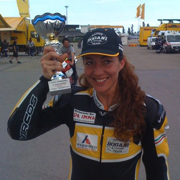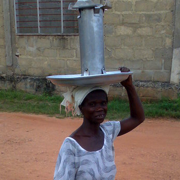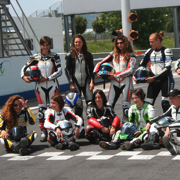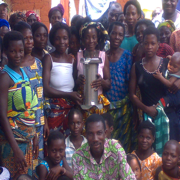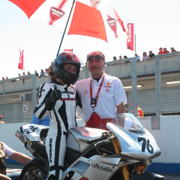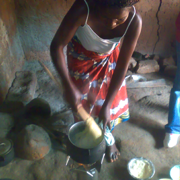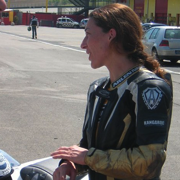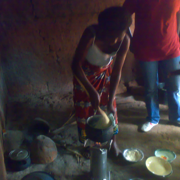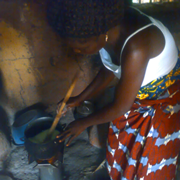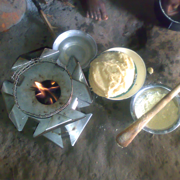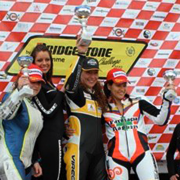Meet Anna Vannetti. Anna is not your everyday person. She is extremely active, and weather she is helping with her family’s business, working in her art studio or competitively racing motorcycles she is trying to be the most she can be while doing as much good as possible.
Almost nothing gives more pleasure to Anna than the feeling of tearing through the turns on the race track, her knee just millimetres off the ground totally focused it’s almost a zen experience for her. She loves racing, but being truly passionate about the environment she struggled with the inherent conflict of interest.
Then she learned about LuciaStoves, she read eagerly about the good they are doing in the world and the people whose lives are improved by them. When she learned that LuciaStoves that are part of WorldStove’s five step program she found out that she could reconcile her love of motorcycles and her love for not only the planet but for helping others. It was not long before she had calculated what her CO2 emissions were from motorcycle racing, and how many LuciaStoves it would take to offset those emissions.
LuciaStoves are unlike traditional improved biomass cookstoves in that rather than burn the biomass they transform it into a clean burning gas and biochar and then use only the gas for cooking. This has many advantages for one the lower emissions for the clean burning LuciaStoves helps address one of the world’s greatest health concerns (click here (see video) ) another great advantage come from the fact that biochar is a safe way to sequester CO2 and at the same time improve soils which leads to better food security and decreased water demands.
Now Anna continues to race and does so knowing that the offsets provided by her not only cancel the CO2 emitted, but go to make the lives of women and children in the country of her choice better.
F.A.Q.
The amount a LuciaStove can measurably sequester will vary slightly based on which country you choose. Different fuels have different energy values so, the amount of fuel required to boil a liter of water will vary. Also, cooking methods vary. Frying is quick, simmering is slow. In general, however, about 20% of the fuel will be converted into biochar. In general, we calculate that an average family of five, cooking three meals a day will produce 300-500 grams of char each day, about 438 kg/year.
Why can the Offset LuciaStove I purchase only go to specific countries?Critical to making our offsets measurable, stoves are distributed only through established WorldStove stove hubs where trained local personnel collect, test, and weigh the biochar so that the external verification groups can thus certify the offsets generated.
What countries may I choose from?For now you may chose from Ghana, Burkina Faso and Haiti. Coming soon Senegal and Rwanda.
Why do stoves have to be tuned?If, for example, you change your own kitchen stove from city gas (methane) to bottled gas (LPG, propane) the stove will have to be adjusted, that is, tuned. In the same way, the gasses emitted in a LuciaStove that burns karité shell waste in Burkina Faso, will be tuned differently from a stove burning bagasse (sugar cane residue) in Haiti.
Why not mass produce LuciaStoves in China or some country with low cost labor to get the cost down?We are opposed to exploiting workers in other countries to save costs. Moreover, one of the primary objectives of WorldStove is to create local, self sustaining jobs while allowing advantages of industrial scale production, lower costs and higher quality. Despite their apparent simplicity, LuciaStoves are made up of precision components, and these can be economically produced only with advanced technology. These components are then shipped disassembled, which greatly reducing shipping costs, and put together by members of stove hubs.
Wood contains sequestered carbon, and another of our objectives is to discourage wood burning.
Why not make LuciaStoves that can run on charcoal?For every ton of charcoal produced, at least five tons of wood must be consumed.
Do all LuciaStoves only work with pellets?No. In some cases, we have found local biomass with the right balance of density and energy content to eliminate the need for pelletization.
Why do some stove hubs make pellets while others do not?See the above answer.
Why does it take up to six months for my stove to arrive?The time it takes to build your stove and inscribe it with your name, serial number, or company logo is relatively brief. Our most critical bottleneck is customs. With some of our programs, shipping and customs can take as little as a few days while others (such as Haiti where the infrastructure is still recovering from the earthquake) it can take months. We conservatively use the longest times as a deadline for delivery.

